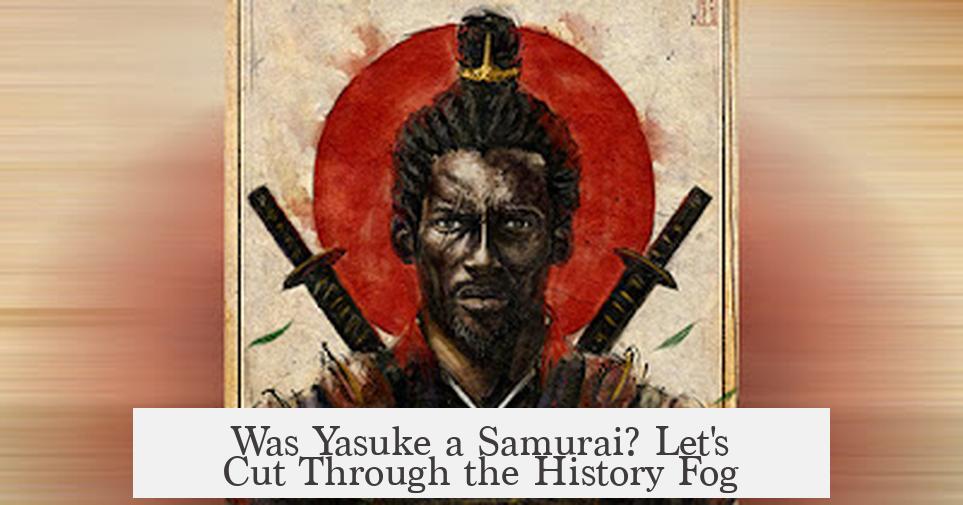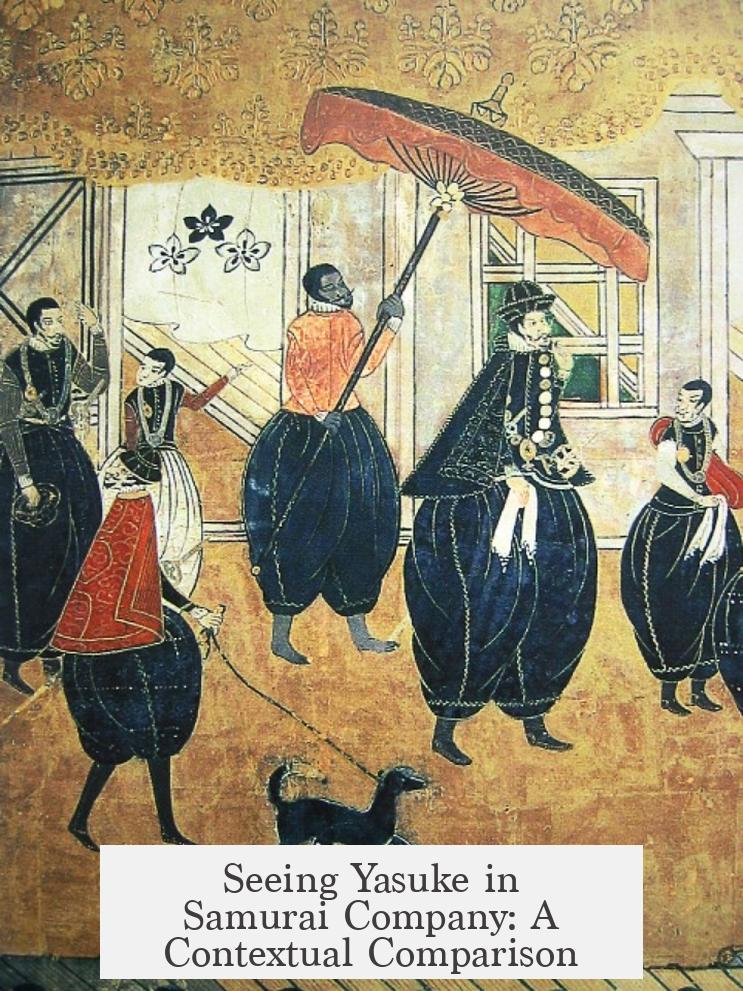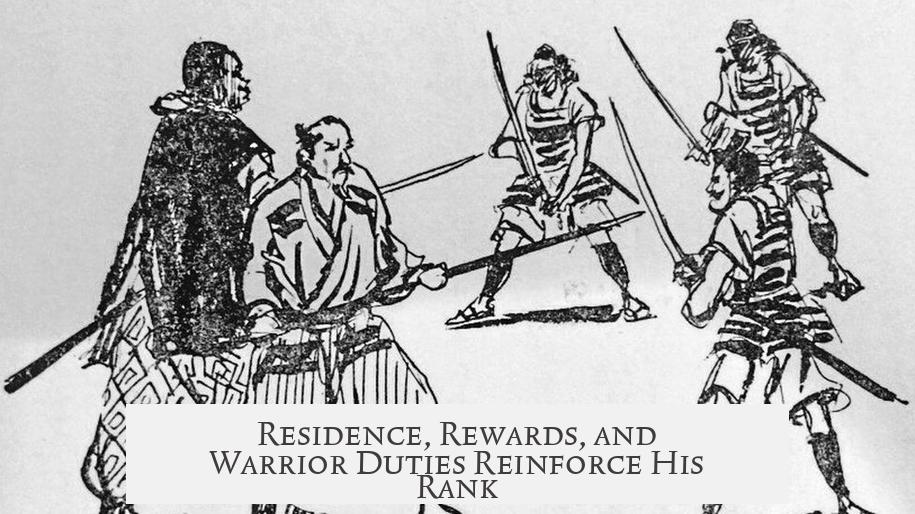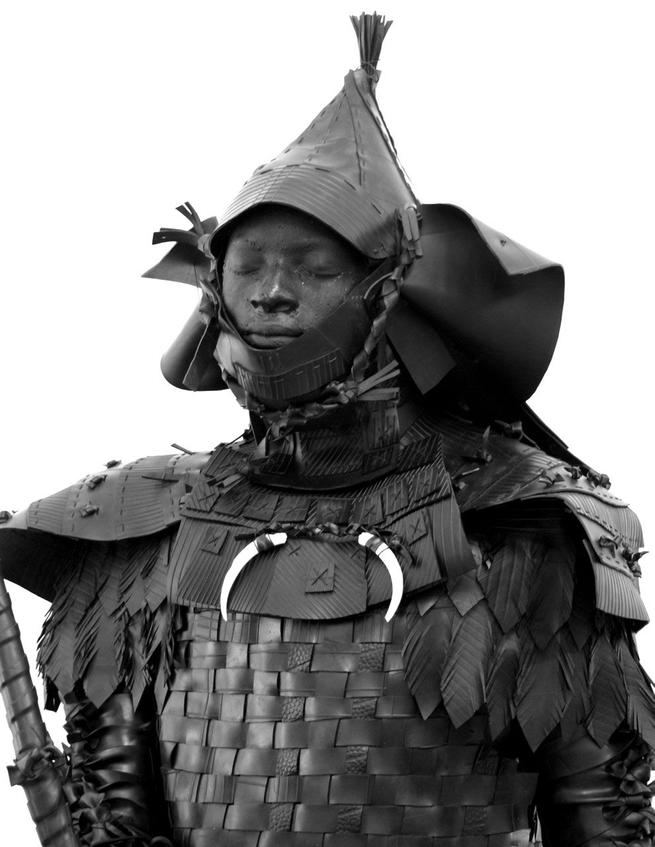Yasuke was indeed a samurai, as confirmed by multiple historical records and scholarly consensus. His receipt of a stipend, carrying of Nobunaga’s weapons, assignment of a private residence, monetary rewards, and active participation in military campaigns collectively affirm his status as a samurai in 16th-century Japan.
The key historical evidence comes from the Shinchōkōki, a chronicle detailing the life of Oda Nobunaga. Yasuke is explicitly noted as receiving a stipend (扶持, fuchi), a term used by contemporary chroniclers solely for samurai or samurai-like retainers. This stipendiary status is crucial because, in that era, stipends were exclusive to those of samurai rank or aspiring samurai, marking official recognition and ranking within the military hierarchy. For instance, known samurai such as Shiba Yoshikane and Kuki Yoshitaka were also granted stipends along with lands or residence.
Yasuke’s role went beyond mere attendance. He served as Nobunaga’s weapon bearer, a duty that was typically reserved for a koshō, a class of young samurai attendants. This assignment implies trust and responsibility, confirming his inclusion within samurai ranks. Furthermore, Nobunaga’s award of a private residence to Yasuke placed him among a select group. The only other non-samurai recipient mentioned in the Shinchōkōki were the Jesuits, highlighting the unusual privilege granted to Yasuke.
Monetary recognition further supports Yasuke’s samurai status. Nobunaga’s nephew, Tsuda Nobuzumi, awarded him 10 kanmon, a sum that exceeded the annual income of some samurai retainers. This was clear acknowledgment of his importance and stature within Nobunaga’s retinue.
Militarily, Yasuke mobilized and actively participated in the Takeda campaign of 1582 alongside Nobunaga. Even when Nobunaga dismissed his ordinary soldiers, Yasuke remained loyal and fought alongside his lord, wielding a katana at the battle of Nijō. This fact further aligns him with established samurai customs centered on battlefield participation and loyalty. His ability to bear arms and serve in combat roles differentiates him from non-combat retainers or servants; it designates him firmly as a warrior of the period.
Scholars emphasize that Yasuke’s samurai rank should not be reduced simply to his receiving a stipend. Instead, a holistic evaluation—stipend, housing, weapon bearing, monetary rewards, military participation—provides conclusive proof of his status. Ota Gyūichi, the chronicler of Shinchōkōki, used the term stipend deliberately for samurai, making Yasuke’s listing indisputable evidence.
Efforts to contest Yasuke’s status often rely on bias or lack of detailed research. Historical consensus and academic studies firmly establish him as a samurai. Without a rigorous academic counterargument, alternative claims remain unfounded. Notably, extensive translations and analyses, such as those by researchers like u/ParallelPain, provide detailed source materials supporting Yasuke’s role as a samurai.
Yasuke’s story also has modern cultural relevance. With media such as the new Assassin’s Creed game trailer increasing interest in his life, popular discourse often revisits Yasuke as a black samurai. This renewed attention underlines the importance of accurate historical representation.
| Evidence | Significance for Yasuke’s Samurai Status |
|---|---|
| Receipt of stipend (扶持, fuchi) | Stipends granted only to samurai or samurai-like retainers |
| Role as weapon bearer (koshō) | Exclusive samurai duty requiring trust and combat readiness |
| Award of private residence | Indicative of formal recognition and rank within Nobunaga’s court |
| Monetary reward (10 kanmon) | Significant income exceeding some samurai retainers |
| Active military service (Takeda campaign, battle of Nijō) | Participation confirmed adherence to samurai roles as warriors |
- Yasuke’s stipend and rewards are consistent with samurai treatment.
- He served as a weapon bearer, a position reserved for samurai attendants.
- He was granted a private residence and notable financial rewards.
- He fought alongside Nobunaga in key military campaigns.
- Historical sources and scholarly consensus support Yasuke’s samurai status.
Was Yasuke a Samurai? Let’s Cut Through the History Fog

Was Yasuke a samurai? Absolutely yes, and here’s the scoop from history itself. He wasn’t just some exotic curiosity or a footnote; the records, specifically the renowned Shinchōkōki, firmly place Yasuke among Nobunaga’s samurai ranks. No guesswork, just straight facts.
But how exactly do we know this? Let’s unravel the story, piece by piece, and see why historians give Yasuke the samurai badge with no hesitation.
Yasuke in the Maeda Clan Chronicles: Why the Stipend Speaks Volumes
The key detail lies in Yasuke receiving a stipend, a private residence, and a short sword with a decorative sheath, as described in the Shinchōkōki, the historical chronicle of the era.
“This black man called Yasuke was given a stipend, a private residence, etc., and was given a short sword with a decorative sheath. He is sometimes seen in the role of weapon bearer.”
Now, before you skim past “stipend” thinking it’s just fancy talk for pocket money, hear this: the Japanese term 扶持 (fuchi), meaning stipend, wasn’t just any allowance. It was a salary reserved specifically for samurai or samurai-like retainers. Ordinary townsfolk or merchants didn’t get this honor. Ōta Gyūichi, the chronicler who penned the Shinchōkōki, uses this term consistently and carefully. If Yasuke got a stipend, he was more than a bodyguard or an oddity; he was a samurai in status.
Seeing Yasuke in Samurai Company: A Contextual Comparison

To make sense of this, let’s peek at other samurai known to receive stipends. For example, Shiba Yoshikane in 1553 was granted enough stipend for commanding 200 men plus a residence. Nobunaga’s key allies like Kuki Yoshitaka and Takigawa Kazumasu received stipends enabling them to maintain 1000 men each. Even a young samurai wrestler named Tomo Shōrin got a stipend, residence, weapons, apparel, and horse — a full samurai package — because of loyalty and skill.
Nobunaga was strict about matching stipends to samurai status. When his nephew reprimanded other samurai for incomplete stipend distribution, it underscored that stipends weren’t handouts. They were rights tied to rank. Yasuke fits right into this system, making a strong case for his samurai rank.
The Weapon Bearer Role: More Than Just a Sword Carrier
You might wonder what it meant that Yasuke was sometimes Nobunaga’s “weapon bearer.” This job, known as koshō, was reserved for samurai. Carrying the Daimyo’s weapons wasn’t just about muscle; it was a sign of trust and status. Yasuke didn’t lug equipment as a servant; he was a warrior entrusted with Nobunaga’s armory.
Residence, Rewards, and Warrior Duties Reinforce His Rank

Adding to his samurai credentials, Nobunaga awarded Yasuke a private residence. In the Shinchōkōki, the only non-samurai to get such a residence were the Jesuits, who had special status. That Yasuke received one puts him in rare company.
And there’s more. Yasuke’s monetary reward from Nobunaga’s nephew Tsuda Nobuzumi—ten kanmon—was quite generous. This sum surpassed the annual income of many samurai. It’s not charity; it’s recognition.
Yasuke didn’t just collect rewards. He was mobilized for Nobunaga’s 1582 Takeda campaign and fought alongside his lord even when Nobunaga disbanded his ordinary soldiers. He wielded a katana, the samurai’s iconic weapon, at the Battle of Nijō. His actions were those of a genuine samurai, not a token figure.
Historians Agree: Yasuke, the Samurai
“Yes. Yes he was. The conclusion of all reasonable historians on the matter is that Yasuke was a samurai, and anyone who disagrees can suck on the historical record.”
That bold statement sums up rigorous academic consensus perfectly. The proof is cumulative: Yasuke received a samurai stipend, carried Nobunaga’s weapons, was housed like a samurai, received considerable money, mobilized with troops, and fought with a katana. These facts aren’t trivial or isolated; they weave a tale of clear samurai status.
Not Just a Black Samurai Myth — Yasuke’s Verified Rank

The myth around Yasuke often paints him as some kind of mysterious foreigner who stumbled into samurai life. In reality, historical records don’t support that casual notion. Yasuke’s journey was official and legit by the standards of 16th-century Japan. His story is a verified example of how a foreigner could rise to samurai status, backed by stipend, arms, and battle honors.
So why does doubt persist? Sometimes, people prefer a sensationalized narrative over carefully analyzed history. If you still doubt Yasuke’s samurai rank after reading this, try producing an academic paper arguing the opposite — with evidence, not guesswork. Otherwise, the historical record wins.
Looking Forward: Yasuke’s Legacy in Popular Culture
Thanks to recent cultural moments like the new Assassin’s Creed game trailer spotlighting Yasuke, expect lots of buzz and curiosity about the Black samurai. This renewed interest invites fresh discussions but should rely on solid history — not just hype.
For those eager to dig deeper, previous detailed research by history buffs like u/ParallelPain offers translations, source comparisons, and nuanced analysis. Exploring these resources enriches your understanding beyond popular claims.
Final Thought: Why Yasuke’s Story Matters
Yasuke’s story shows that samurai status wasn’t limited by race or origin but earned through loyalty, weapon mastery, and service. It challenges assumptions about Japan’s samurai class and opens doors to appreciating the diverse threads in global warrior histories.
In the end, Yasuke wasn’t just a curiosity or a legend — he was a samurai, recognized and respected in his time. That’s a fact from the historical record, not a fantasy.
| Key Evidence | Explanation |
|---|---|
| Stipend (扶持, fuchi) | Reserved for samurai; Yasuke received one |
| Carrying Nobunaga’s Weapons | Role of koshō, a samurai position |
| Private Residence Awarded | Exclusive honor, indicating samurai rank |
| Monetary Gift (10 kanmon) | More than some samurai annual incomes |
| Military Campaign Participation | Fought alongside Nobunaga with katana |
So, next time someone asks, “Was Yasuke a samurai?” you have a solid history-backed answer — and the receipts to prove it.
Was Yasuke officially recognized as a samurai?
Yes. Yasuke received a samurai stipend, a private residence, and a short sword. These benefits were typically reserved for samurai, indicating his official status.
What evidence shows Yasuke acted as a samurai during campaigns?
He carried Nobunaga’s weapons, a task usually done by samurai called koshō. Yasuke fought with a katana and stayed by Nobunaga’s side even after ordinary soldiers were dismissed.
How significant was the stipend Yasuke received?
The stipend (扶持) was crucial. In that era, it was granted only to samurai or retainers. Receiving this stipend was a key sign of Yasuke’s samurai rank.
Did Yasuke receive any rewards that samurai commonly got?
- Yes, Nobunaga awarded him a residence, a privilege given only to samurai or select individuals like Jesuits.
- He also received 10 kanmon money from Nobunaga’s nephew, more than some samurai earned yearly.
Why do historians agree Yasuke was a samurai?
Historical records show Yasuke’s stipend, role carrying weapons, residence award, and active participation in battle. These factors combined prove his samurai status.
Are there any challenges to Yasuke’s samurai status?
Most historians accept his status based on records. Those who disagree need to provide academic evidence contradicting these facts.



